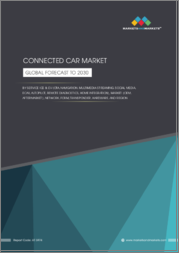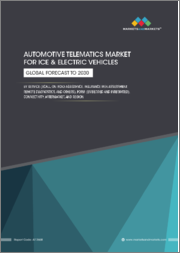
|
시장보고서
상품코드
1373649
세계의 자동차 Ecall 시장 규모, 점유율, 산업 동향 분석 보고서 : 트리거 유형별, 추진력 유형별, 차량 유형별, 지역별 전망과 예측(2023-2030년)Global Automotive Ecalls Market Size, Share & Industry Trends Analysis Report By Trigger Type, By Propulsion Type (IC Engine, and Electric), By Vehicle Type (Passenger Cars, and Commercial Vehicles), By Regional Outlook and Forecast, 2023 - 2030 |
||||||
자동차 Ecall 시장 규모는 2030년까지 68억 달러에 달할 것으로 예상되며, 예측 기간 동안 연평균 10.3%의 시장 성장률을 기록할 것으로 예상됩니다.
그러나 자동차 eCall 시스템과 기존 인프라의 호환성은 시장에 도전과제를 가져올 수 있습니다. 이러한 과제는 eCall 시스템이 긴급 서비스 및 기타 인프라 요소에 안정적으로 연결하고 데이터를 전송할 수 있도록 하는 데서 비롯됩니다. 지역과 국가마다 긴급 대응 및 통신을 위한 기술 인프라의 수준은 다양하며, eCall 시스템은 선진화된 도심부터 자원이 부족한 시골까지 다양한 인프라 구성과 호환되어야 합니다. 지역에 따라서는 오래된 기술과 프로토콜에 의존하는 레거시 비상 대응 시스템이 있는 경우도 있습니다. 따라서 자동차 EC 콜의 복잡성은 시장 성장에 걸림돌로 작용할 수 있습니다.
트리거의 전망
트리거 유형에 따라 시장은 자동 발신 eCall(AIeC)과 수동 발신 eCall(MieC)로 구분되며, 2022년 시장에서는 자동 발신 eCall(AIeC) 분야가 가장 높은 매출 점유율을 차지했습니다. 없이 중대사고 발생 즉시 긴급 신고를 시작할 수 있다는 점입니다. AIeC 시스템은 사고의 위치, 심각성, 탑승자 수에 대한 정확하고 상세한 정보를 제공함으로써 긴급 구조대가 보다 효과적으로 대응할 수 있도록 돕습니다. 이 정보를 통해 응급 서비스 기관이 보다 효과적으로 대응하고 적절한 자원을 파견하는 데 도움이 될 수 있습니다.
추진력 전망
추진력 유형에 따라 시장은 IC 엔진과 전기로 나뉘며, 2022년 시장에서는 전기 부문이 상당한 성장률을 기록했습니다. 대기오염과 기후변화에 대한 우려가 커지면서 소비자들은 더 깨끗하고 지속가능한 교통수단을 찾고 있으며, EV는 테일파이프 배출이 전혀 없기 때문에 환경에 민감한 구매자들에게 매력적인 선택이 되고 있습니다. 자동차 제조업체들은 세단, SUV, 트럭 등 다양한 종류의 EV 모델을 출시하고 있으며, EV의 전자 호출 시스템은 사용자의 프라이버시와 데이터 보호를 최우선 과제로 삼고 있습니다.
자동차 전망
차량 유형에 따라 시장은 승용차와 상용차로 구분됩니다. 승용차의 eCall 시스템은 교통 안전을 개선하고, 긴급 상황 대응 시간을 단축하며, 필요한 경우 신속한 구조를 보장하는 데 도움이 되며, eCall 시스템은 최신 자동차에서 점점 더 중요해지고 있는 안전과 보안 수준을 제공하여 전반적인 교통 안전과 차량 탑승자의 행복에 기여합니다.
지역별 전망
지역별로 보면 시장은 북미, 유럽, 아시아태평양 및 LAMEA로 분석됩니다. 아시아태평양은 2022년 시장에서 상당한 매출 점유율을 차지했습니다. 특히 한국, 인도, 일본과 같은 아시아 신흥국들은 자동차에 eCall 시스템을 광범위하게 채택함으로써 자동차 안전 개선에 대한 의지를 보여주고 있습니다. 이들 국가는 자국의 고유한 교통안전 문제를 해결하고 교통 사고로 인한 치명적인 영향을 줄이기 위해 이러한 기술의 잠재력을 인식하고 있습니다. 이러한 장치들은 긴급 상황에서 즉각적인 지원을 용이하게 하고, 차량의 움직임을 추적하고, 촉진요인의 행동을 모니터링하며, 전반적인 차량 관리를 지원함으로써 시장 성장을 더욱 촉진하고 있습니다.
목차
제1장 시장 범위와 조사 방법
- 시장 정의
- 목적
- 시장 범위
- 세분화
- 조사 방법
제2장 시장 개요
- 주요 하이라이트
제3장 시장 개요
- 서론
- 개요
- 시장 구성과 시나리오
- 개요
- 시장에 영향을 미치는 주요 요인
- 시장 성장 촉진요인
- 시장 성장 억제요인
- Porter's Five Forces 분석
제4장 세계의 자동차 Ecall 시장 : 트리거 유형별
- 세계의 자동 개시 eCall(AIeC) 시장 : 지역별
- 세계의 수동 개시 eCall(MIeC) 시장 : 지역별
제5장 세계의 자동차 Ecall 시장 : 추진 유형별
- 세계의 IC 엔진 시장 : 지역별
- 세계의 전력 시장 : 지역별
제6장 세계의 자동차 Ecall 시장 : 차종별
- 세계의 승용차 시장 : 지역별
- 세계의 상용차 시장 : 지역별
제7장 세계의 자동차 Ecall 시장 : 지역별
- 북미
- 북미의 시장 : 국가별
- 미국
- 캐나다
- 멕시코
- 기타 북미
- 북미의 시장 : 국가별
- 유럽
- 유럽의 시장 : 국가별
- 독일
- 영국
- 프랑스
- 러시아
- 노르웨이
- 네덜란드
- 기타 유럽
- 유럽의 시장 : 국가별
- 아시아태평양
- 아시아태평양의 시장 : 국가별
- 중국
- 일본
- 말레이시아
- 인도
- 한국
- 싱가포르
- 기타 아시아태평양
- 아시아태평양의 시장 : 국가별
- 라틴아메리카, 중동 및 아프리카
- 라틴아메리카, 중동 및 아프리카 시장 : 국가별
- 브라질
- 아르헨티나
- 아랍에미리트
- 사우디아라비아
- 남아프리카공화국
- 나이지리아
- 기타 라틴아메리카, 중동 및 아프리카
- 라틴아메리카, 중동 및 아프리카 시장 : 국가별
제8장 기업 개요
- Aptiv PLC
- Telit corporate group(DBAY Advisors Limited)
- LG Electronics, Inc(LG Corporation)
- Valeo SA
- Samsung Electronics Co, Ltd.(Samsung Group)
- U-blox Holding AG
- Thales Group SA
- Denso Corporation
- Continental AG
- Panasonic Holdings Corporation
제9장 자동차 Ecalls 시장의 성공 필수 사항
ksm 23.11.13The Global Automotive Ecalls Market size is expected to reach $6.8 billion by 2030, rising at a market growth of 10.3% CAGR during the forecast period.
The World Health Organization states that roughly 1.3 million individuals die annually in road traffic accidents. 93% of global road fatalities occur in low- and middle-income countries, even though these nations possess approximately 60% of the world's vehicles. MIeC serves as a crucial safety net, allowing drivers or passengers to swiftly summon help when faced with a critical situation. Consequently, the Manually Initiated eCall (MieC) segment would generate approximately 1/5thshare of the market by 2030. By offering this manual initiation option, automotive eCall systems provide an extra layer of security, ensuring rapid response from emergency services. This enables quicker dispatch of medical assistance to the scene, reducing the time injured individuals have to wait for medical care. This is particularly important in severe accidents where rapid medical intervention can substantially affect outcomes. Some of the factors affecting the market are the development of next-generation telematics, stringent government regulations regarding safety, and compatibility with existing infrastructure for ecall systems.
The development of next-generation telematics protocols is a substantial factor contributing to the growth of the market. Telematics protocols enable communication between vehicles and external systems, including eCall systems. Next-generation telematics protocols, such as 5G and advanced versions of 4G LTE, offer significantly faster data transmission speeds and lower latency. This enables eCall systems to transmit a wider range of data quickly and reliably. These protocols enable faster, more reliable, and data-rich communication between vehicles and emergency services, ultimately enhancing road safety and the effectiveness of eCall responses. As a result, they play a crucial role in supporting the growth and adoption of eCall technology in the automotive industry and, thus, propel the growth of the market. Moreover, Governments worldwide have recognized the potential of eCall technology to enhance road safety and emergency response, leading to the implementation of regulations that mandate the inclusion of eCall systems in new vehicles. These regulations align with broader goals of improving road safety and emergency response, and they drive the adoption of eCall technology by automakers and consumers, ultimately propelling market growth.
However, the compatibility of automotive eCall systems with existing infrastructure can present challenges for the market. These challenges arise from ensuring that eCall systems can connect with and transmit data to emergency services and other infrastructure elements. Different regions and nations have varying levels of technological infrastructure for emergency response and communication. ECall systems must be compatible with various infrastructure configurations, from advanced urban centers to rural areas with limited resources. Some regions may have legacy emergency response systems that rely on older technologies and protocols. Thus, the complexity of automotive ecalls will decline the expansion of the market growth.
Trigger Outlook
On the basis of trigger type, the market is bifurcated into automatically initiated eCall (AIeC) and manually initiated eCall (MieC). The automatically initiated eCall (AIeC) segment garnered the highest revenue share in the market in 2022. One of the primary benefits of AIeC is its ability to initiate an emergency call immediately after a severe accident, without the need for driver intervention. This rapid response can be crucial in situations where every second counts, potentially saving lives. AIeC systems provide accurate and detailed information about the accident's location, severity, and the number of occupants in the vehicle. This information helps emergency services respond more effectively and dispatch appropriate resources.
Propulsion Outlook
Based on propulsion type, the market is divided into IC engine and electric. The electric segment recorded a considerable growth rate in the market in 2022. Growing concerns about air pollution and climate change have led consumers to seek cleaner and more sustainable transportation options. EVs produce zero tailpipe emissions, making them an attractive choice for environmentally conscious buyers. Automakers are offering an increasing variety of EV models, including sedans, SUVs, and even trucks. This diversity allows consumers to find an EV that suits their preferences and needs. eCall systems in Evs prioritize user privacy and data protection.
Vehicle Outlook
By vehicle type, the market is segmented into passenger cars and commercial vehicles. The passenger cars segment witnessed the maximum revenue share in the market in 2022. eCall systems in passenger cars are instrumental in improving road safety, reducing response times in emergencies, and ensuring that help is promptly dispatched when needed. They offer a level of safety and security that is increasingly important in modern vehicles, contributing to overall traffic safety and the well-being of vehicle occupants.
Regional Outlook
Region-wise, the market is analyzed across North America, Europe, Asia Pacific, and LAMEA. The Asia Pacific region covered a considerable revenue share in the market in 2022. Developing countries, specifically in Asia, such as South Korea, India, Japan, and others, have demonstrated a growing commitment to enhancing automotive safety through the extensive adoption of eCall systems in vehicles. These nations recognize the potential of such technology to address their unique road safety challenges and mitigate the devastating impact of road accidents. These devices facilitate immediate assistance in emergencies and aid in tracking vehicle movements, driver behavior monitoring, and overall fleet management, further boosting the market growth.
The market research report covers the analysis of key stakeholders of the market. Key companies profiled in the report include Aptiv PLC, Telit corporate group (DBAY Advisors Limited), LG Electronics, Inc. (LG Corporation), Valeo SA, Samsung Electronics Co., Ltd. (Samsung Group), U-blox Holding AG, Thales Group S.A., Denso Corporation, Continental AG, Panasonic Holdings Corporation.
Scope of the Study
Market Segments covered in the Report:
By Trigger Type
- Automatically Initiated eCall (AIeC)
- Manually Initiated eCall (MIeC)
By Propulsion Type
- IC Engine
- Electric
By Vehicle Type
- Passenger Cars
- Commercial Vehicles
By Geography
- North America
- US
- Canada
- Mexico
- Rest of North America
- Europe
- Germany
- UK
- France
- Russia
- Norway
- Netherland
- Rest of Europe
- Asia Pacific
- China
- Japan
- India
- South Korea
- Singapore
- Malaysia
- Rest of Asia Pacific
- LAMEA
- Brazil
- Argentina
- UAE
- Saudi Arabia
- South Africa
- Nigeria
- Rest of LAMEA
Companies Profiled
- Aptiv PLC
- Telit corporate group (DBAY Advisors Limited)
- LG Electronics, Inc. (LG Corporation)
- Valeo SA
- Samsung Electronics Co., Ltd. (Samsung Group)
- U-blox Holding AG
- Thales Group S.A.
- Denso Corporation
- Continental AG
- Panasonic Holdings Corporation
Unique Offerings from KBV Research
- Exhaustive coverage
- Highest number of market tables and figures
- Subscription based model available
- Guaranteed best price
- Assured post sales research support with 10% customization free
Table of Contents
Chapter 1. Market Scope & Methodology
- 1.1 Market Definition
- 1.2 Objectives
- 1.3 Market Scope
- 1.4 Segmentation
- 1.4.1 Global Automotive Ecalls Market, by Trigger Type
- 1.4.2 Global Automotive Ecalls Market, by Propulsion Type
- 1.4.3 Global Automotive Ecalls Market, by Vehicle Type
- 1.4.4 Global Automotive Ecalls Market, by Geography
- 1.5 Methodology for the research
Chapter 2. Market At a Glance
- 2.1 Key Highlights
Chapter 3. Market Overview
- 3.1 Introduction
- 3.1.1 Overview
- 3.1.1.1 Market Composition and Scenario
- 3.1.1 Overview
- 3.2 Key Factors Impacting the Market
- 3.2.1 Market Drivers
- 3.2.2 Market Restraints
- 3.3 Porter's Five Force Analysis
Chapter 4. Global Automotive Ecalls Market by Trigger Type
- 4.1 Global Automatically Initiated eCall (AIeC) Market by Region
- 4.2 Global Manually Initiated eCall (MIeC) Market by Region
Chapter 5. Global Automotive Ecalls Market by Propulsion Type
- 5.1 Global IC Engine Market by Region
- 5.2 Global Electric Market by Region
Chapter 6. Global Automotive Ecalls Market by Vehicle Type
- 6.1 Global Passenger Cars Market by Region
- 6.2 Global Commercial Vehicles Market by Region
Chapter 7. Global Automotive Ecalls Market by Region
- 7.1 North America Automotive Ecalls Market
- 7.1.1 North America Automotive Ecalls Market by Trigger Type
- 7.1.1.1 North America Automatically Initiated eCall (AIeC) Market by Country
- 7.1.1.2 North America Manually Initiated eCall (MIeC) Market by Country
- 7.1.2 North America Automotive Ecalls Market by Propulsion Type
- 7.1.2.1 North America IC Engine Market by Country
- 7.1.2.2 North America Electric Market by Country
- 7.1.3 North America Automotive Ecalls Market by Vehicle Type
- 7.1.3.1 North America Passenger Cars Market by Country
- 7.1.3.2 North America Commercial Vehicles Market by Country
- 7.1.4 North America Automotive Ecalls Market by Country
- 7.1.4.1 US Automotive Ecalls Market
- 7.1.4.1.1 US Automotive Ecalls Market by Trigger Type
- 7.1.4.1.2 US Automotive Ecalls Market by Propulsion Type
- 7.1.4.1.3 US Automotive Ecalls Market by Vehicle Type
- 7.1.4.2 Canada Automotive Ecalls Market
- 7.1.4.2.1 Canada Automotive Ecalls Market by Trigger Type
- 7.1.4.2.2 Canada Automotive Ecalls Market by Propulsion Type
- 7.1.4.2.3 Canada Automotive Ecalls Market by Vehicle Type
- 7.1.4.3 Mexico Automotive Ecalls Market
- 7.1.4.3.1 Mexico Automotive Ecalls Market by Trigger Type
- 7.1.4.3.2 Mexico Automotive Ecalls Market by Propulsion Type
- 7.1.4.3.3 Mexico Automotive Ecalls Market by Vehicle Type
- 7.1.4.4 Rest of North America Automotive Ecalls Market
- 7.1.4.4.1 Rest of North America Automotive Ecalls Market by Trigger Type
- 7.1.4.4.2 Rest of North America Automotive Ecalls Market by Propulsion Type
- 7.1.4.4.3 Rest of North America Automotive Ecalls Market by Vehicle Type
- 7.1.4.1 US Automotive Ecalls Market
- 7.1.1 North America Automotive Ecalls Market by Trigger Type
- 7.2 Europe Automotive Ecalls Market
- 7.2.1 Europe Automotive Ecalls Market by Trigger Type
- 7.2.1.1 Europe Automatically Initiated eCall (AIeC) Market by Country
- 7.2.1.2 Europe Manually Initiated eCall (MIeC) Market by Country
- 7.2.2 Europe Automotive Ecalls Market by Propulsion Type
- 7.2.2.1 Europe IC Engine Market by Country
- 7.2.2.2 Europe Electric Market by Country
- 7.2.3 Europe Automotive Ecalls Market by Vehicle Type
- 7.2.3.1 Europe Passenger Cars Market by Country
- 7.2.3.2 Europe Commercial Vehicles Market by Country
- 7.2.4 Europe Automotive Ecalls Market by Country
- 7.2.4.1 Germany Automotive Ecalls Market
- 7.2.4.1.1 Germany Automotive Ecalls Market by Trigger Type
- 7.2.4.1.2 Germany Automotive Ecalls Market by Propulsion Type
- 7.2.4.1.3 Germany Automotive Ecalls Market by Vehicle Type
- 7.2.4.2 UK Automotive Ecalls Market
- 7.2.4.2.1 UK Automotive Ecalls Market by Trigger Type
- 7.2.4.2.2 UK Automotive Ecalls Market by Propulsion Type
- 7.2.4.2.3 UK Automotive Ecalls Market by Vehicle Type
- 7.2.4.3 France Automotive Ecalls Market
- 7.2.4.3.1 France Automotive Ecalls Market by Trigger Type
- 7.2.4.3.2 France Automotive Ecalls Market by Propulsion Type
- 7.2.4.3.3 France Automotive Ecalls Market by Vehicle Type
- 7.2.4.4 Russia Automotive Ecalls Market
- 7.2.4.4.1 Russia Automotive Ecalls Market by Trigger Type
- 7.2.4.4.2 Russia Automotive Ecalls Market by Propulsion Type
- 7.2.4.4.3 Russia Automotive Ecalls Market by Vehicle Type
- 7.2.4.5 Norway Automotive Ecalls Market
- 7.2.4.5.1 Norway Automotive Ecalls Market by Trigger Type
- 7.2.4.5.2 Norway Automotive Ecalls Market by Propulsion Type
- 7.2.4.5.3 Norway Automotive Ecalls Market by Vehicle Type
- 7.2.4.6 Netherlands Automotive Ecalls Market
- 7.2.4.6.1 Netherlands Automotive Ecalls Market by Trigger Type
- 7.2.4.6.2 Netherlands Automotive Ecalls Market by Propulsion Type
- 7.2.4.6.3 Netherlands Automotive Ecalls Market by Vehicle Type
- 7.2.4.7 Rest of Europe Automotive Ecalls Market
- 7.2.4.7.1 Rest of Europe Automotive Ecalls Market by Trigger Type
- 7.2.4.7.2 Rest of Europe Automotive Ecalls Market by Propulsion Type
- 7.2.4.7.3 Rest of Europe Automotive Ecalls Market by Vehicle Type
- 7.2.4.1 Germany Automotive Ecalls Market
- 7.2.1 Europe Automotive Ecalls Market by Trigger Type
- 7.3 Asia Pacific Automotive Ecalls Market
- 7.3.1 Asia Pacific Automotive Ecalls Market by Trigger Type
- 7.3.1.1 Asia Pacific Automatically Initiated eCall (AIeC) Market by Country
- 7.3.1.2 Asia Pacific Manually Initiated eCall (MIeC) Market by Country
- 7.3.2 Asia Pacific Automotive Ecalls Market by Propulsion Type
- 7.3.2.1 Asia Pacific IC Engine Market by Country
- 7.3.2.2 Asia Pacific Electric Market by Country
- 7.3.3 Asia Pacific Automotive Ecalls Market by Vehicle Type
- 7.3.3.1 Asia Pacific Passenger Cars Market by Country
- 7.3.3.2 Asia Pacific Commercial Vehicles Market by Country
- 7.3.4 Asia Pacific Automotive Ecalls Market by Country
- 7.3.4.1 China Automotive Ecalls Market
- 7.3.4.1.1 China Automotive Ecalls Market by Trigger Type
- 7.3.4.1.2 China Automotive Ecalls Market by Propulsion Type
- 7.3.4.1.3 China Automotive Ecalls Market by Vehicle Type
- 7.3.4.2 Japan Automotive Ecalls Market
- 7.3.4.2.1 Japan Automotive Ecalls Market by Trigger Type
- 7.3.4.2.2 Japan Automotive Ecalls Market by Propulsion Type
- 7.3.4.2.3 Japan Automotive Ecalls Market by Vehicle Type
- 7.3.4.3 Malaysia Automotive Ecalls Market
- 7.3.4.3.1 Malaysia Automotive Ecalls Market by Trigger Type
- 7.3.4.3.2 Malaysia Automotive Ecalls Market by Propulsion Type
- 7.3.4.3.3 Malaysia Automotive Ecalls Market by Vehicle Type
- 7.3.4.4 India Automotive Ecalls Market
- 7.3.4.4.1 India Automotive Ecalls Market by Trigger Type
- 7.3.4.4.2 India Automotive Ecalls Market by Propulsion Type
- 7.3.4.4.3 India Automotive Ecalls Market by Vehicle Type
- 7.3.4.5 South Korea Automotive Ecalls Market
- 7.3.4.5.1 South Korea Automotive Ecalls Market by Trigger Type
- 7.3.4.5.2 South Korea Automotive Ecalls Market by Propulsion Type
- 7.3.4.5.3 South Korea Automotive Ecalls Market by Vehicle Type
- 7.3.4.6 Singapore Automotive Ecalls Market
- 7.3.4.6.1 Singapore Automotive Ecalls Market by Trigger Type
- 7.3.4.6.2 Singapore Automotive Ecalls Market by Propulsion Type
- 7.3.4.6.3 Singapore Automotive Ecalls Market by Vehicle Type
- 7.3.4.7 Rest of Asia Pacific Automotive Ecalls Market
- 7.3.4.7.1 Rest of Asia Pacific Automotive Ecalls Market by Trigger Type
- 7.3.4.7.2 Rest of Asia Pacific Automotive Ecalls Market by Propulsion Type
- 7.3.4.7.3 Rest of Asia Pacific Automotive Ecalls Market by Vehicle Type
- 7.3.4.1 China Automotive Ecalls Market
- 7.3.1 Asia Pacific Automotive Ecalls Market by Trigger Type
- 7.4 LAMEA Automotive Ecalls Market
- 7.4.1 LAMEA Automotive Ecalls Market by Trigger Type
- 7.4.1.1 LAMEA Automatically Initiated eCall (AIeC) Market by Country
- 7.4.1.2 LAMEA Manually Initiated eCall (MIeC) Market by Country
- 7.4.2 LAMEA Automotive Ecalls Market by Propulsion Type
- 7.4.2.1 LAMEA IC Engine Market by Country
- 7.4.2.2 LAMEA Electric Market by Country
- 7.4.3 LAMEA Automotive Ecalls Market by Vehicle Type
- 7.4.3.1 LAMEA Passenger Cars Market by Country
- 7.4.3.2 LAMEA Commercial Vehicles Market by Country
- 7.4.4 LAMEA Automotive Ecalls Market by Country
- 7.4.4.1 Brazil Automotive Ecalls Market
- 7.4.4.1.1 Brazil Automotive Ecalls Market by Trigger Type
- 7.4.4.1.2 Brazil Automotive Ecalls Market by Propulsion Type
- 7.4.4.1.3 Brazil Automotive Ecalls Market by Vehicle Type
- 7.4.4.2 Argentina Automotive Ecalls Market
- 7.4.4.2.1 Argentina Automotive Ecalls Market by Trigger Type
- 7.4.4.2.2 Argentina Automotive Ecalls Market by Propulsion Type
- 7.4.4.2.3 Argentina Automotive Ecalls Market by Vehicle Type
- 7.4.4.3 UAE Automotive Ecalls Market
- 7.4.4.3.1 UAE Automotive Ecalls Market by Trigger Type
- 7.4.4.3.2 UAE Automotive Ecalls Market by Propulsion Type
- 7.4.4.3.3 UAE Automotive Ecalls Market by Vehicle Type
- 7.4.4.4 Saudi Arabia Automotive Ecalls Market
- 7.4.4.4.1 Saudi Arabia Automotive Ecalls Market by Trigger Type
- 7.4.4.4.2 Saudi Arabia Automotive Ecalls Market by Propulsion Type
- 7.4.4.4.3 Saudi Arabia Automotive Ecalls Market by Vehicle Type
- 7.4.4.5 South Africa Automotive Ecalls Market
- 7.4.4.5.1 South Africa Automotive Ecalls Market by Trigger Type
- 7.4.4.5.2 South Africa Automotive Ecalls Market by Propulsion Type
- 7.4.4.5.3 South Africa Automotive Ecalls Market by Vehicle Type
- 7.4.4.6 Nigeria Automotive Ecalls Market
- 7.4.4.6.1 Nigeria Automotive Ecalls Market by Trigger Type
- 7.4.4.6.2 Nigeria Automotive Ecalls Market by Propulsion Type
- 7.4.4.6.3 Nigeria Automotive Ecalls Market by Vehicle Type
- 7.4.4.7 Rest of LAMEA Automotive Ecalls Market
- 7.4.4.7.1 Rest of LAMEA Automotive Ecalls Market by Trigger Type
- 7.4.4.7.2 Rest of LAMEA Automotive Ecalls Market by Propulsion Type
- 7.4.4.7.3 Rest of LAMEA Automotive Ecalls Market by Vehicle Type
- 7.4.4.1 Brazil Automotive Ecalls Market
- 7.4.1 LAMEA Automotive Ecalls Market by Trigger Type
Chapter 8. Company Profiles
- 8.1 Aptiv PLC
- 8.1.1 Company Overview
- 8.1.2 Financial Analysis
- 8.1.3 Segmental and Regional Analysis
- 8.1.4 Research & Development Expense
- 8.1.5 Recent strategies and developments:
- 8.1.5.1 Partnerships, Collaborations, and Agreements:
- 8.1.5.2 Geographical Expansions:
- 8.1.6 SWOT Analysis
- 8.2 Telit corporate group (DBAY Advisors Limited)
- 8.2.1 Company Overview
- 8.2.2 SWOT Analysis
- 8.3 LG Electronics, Inc. (LG Corporation)
- 8.3.1 Company Overview
- 8.3.2 Financial Analysis
- 8.3.3 Regional & Segmental Analysis
- 8.3.4 Research & Development Expenses
- 8.3.5 Recent strategies and developments:
- 8.3.5.1 Partnerships, Collaborations, and Agreements:
- 8.3.6 SWOT Analysis
- 8.4 Valeo SA
- 8.4.1 Company Overview
- 8.4.2 Financial Analysis
- 8.4.3 Segmental and Regional Analysis
- 8.4.4 Research & Development Expense
- 8.4.5 SWOT Analysis
- 8.5 Samsung Electronics Co., Ltd. (Samsung Group)
- 8.5.1 Company Overview
- 8.5.2 Financial Analysis
- 8.5.3 Segmental and Regional Analysis
- 8.5.4 SWOT Analysis
- 8.6 U-blox Holding AG
- 8.6.1 Company Overview
- 8.6.2 Financial Analysis
- 8.6.3 Segment and Regional Analysis
- 8.6.4 Research & Development Expense
- 8.6.5 Recent strategies and developments:
- 8.6.5.1 Partnerships, Collaborations, and Agreements:
- 8.6.5.2 Product Launches and Product Expansions:
- 8.6.6 SWOT Analysis
- 8.7 Thales Group S.A.
- 8.7.1 Company Overview
- 8.7.2 Financial Analysis
- 8.7.3 Segmental and Regional Analysis
- 8.7.4 Research & Development Expenses
- 8.7.5 SWOT Analysis
- 8.8 Denso Corporation
- 8.8.1 Company Overview
- 8.8.2 Financial Analysis
- 8.8.3 Regional Analysis
- 8.8.4 SWOT Analysis
- 8.9 Continental AG
- 8.9.1 Company Overview
- 8.9.2 Financial Analysis
- 8.9.3 Segmental and Regional Analysis
- 8.9.4 Research & Development Expense
- 8.9.5 Recent strategies and developments:
- 8.9.5.1 Partnerships, Collaborations, and Agreements:
- 8.9.6 SWOT Analysis
- 8.10. Panasonic Holdings Corporation
- 8.10.1 Company Overview
- 8.10.2 Financial Analysis
- 8.10.3 Segmental and Regional Analysis
- 8.10.4 Research & Development Expenses
- 8.10.5 SWOT Analysis



















